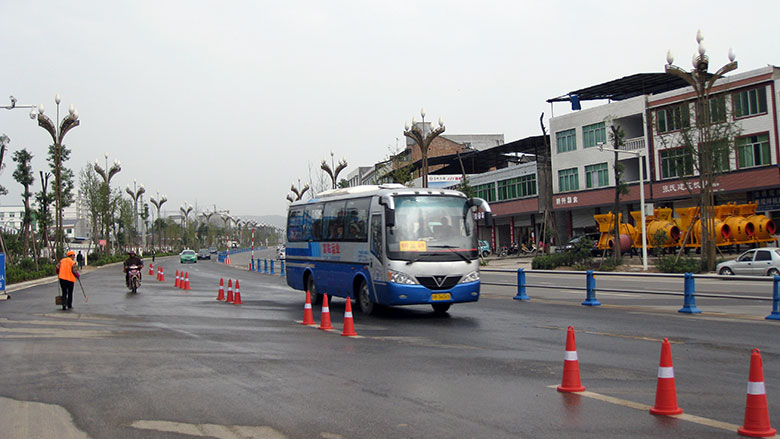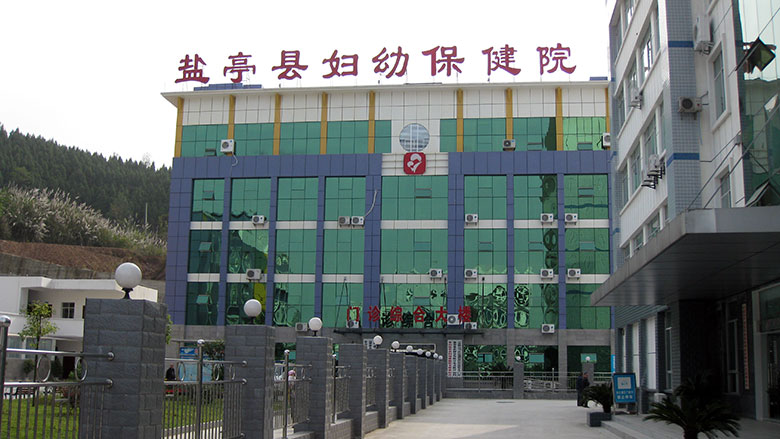Results
The project was implemented in 27 severely affected counties in Sichuan and Gansu between 2009 and 2014, and restored and enhanced access to essential infrastructure and other public services, such as water, sanitation, roads, health and education, but also greatly enhanced the services from pre-earthquake levels and contributed to rapid recovery and growth of the local economies, specifically:
- Roads. 300 roads were built or renovated to new seismic standards, with new traffic management system, drainage, lighting and landscaping.

- Water. Ten water supply plants were built with 230 km of water supply pipelines and four pumping stations, improving access to households and commercial and industrial users, as well as for urban fire-fighting purposes. This led to an increase of 25% in coverage of households and commercial buildings with a continuous 24-hour water supply compared to the pre-earthquake situation.
- Wastewater. Nine wastewater treatment plants were rehabilitated or constructed, and 102.5 km of sewerage pipelines and 492.5 km of storm water drainage pipelines were built. As a result, the sewage treatment ratio in the project counties increased by over 50% compared to the pre-earthquake situation.
- Solid waste collection and disposal (Sichuan only). Investments under this project led to an average increase of 42% in the collection and disposal ratio of solid waste garbage compared to the pre-earthquake situation.
- Health. 67 health facilities were built, equipped and are fully operational. The number of hospital beds in the project counties increased by 67% and 35% in Sichuan and Gansu respectively. The new facilities has greatly enhanced diagnostic and treatment capacities and provide a wider range of in-patient and out-patient medical services, resulting in higher admissions than before the earthquake.

- Education (Gansu Only). Seven new schools were built and equipped with text books, computer equipment and laboratories, classroom, canteen and dormitory furniture, and sporting equipment. Training courses were provided for 450 principals, teachers and administrators, and covered a broad range of education topics, including new emergency management procedures.
- Capacity building. The provincial, municipal and county level governments of both provinces benefited from a broad range of training and capacity building activities related to the World Bank’s safeguards, financial management and procurement, as well as technical areas such as investigation, design and contract supervision, with a total of 3,701 training days completed.
- Economic growth. Compared with pre-earthquake level, GDP grew between 117% and 198%, primarily driven by growth in the non-agricultural sectors. Secondary industries (including both industrial and construction sectors) increased between 116% and 286% and service sectors grew by 135% and 201%. Per capita income across the board increased between 90% and 154% in project counties.
Bank Group Contribution
A US$710 million Emergency Loan was provided by the International Bank for Reconstruction and Development (IBRD) to support recovery investments in Sichuan (US$510 million) and Gansu (US$200 million), focusing on the reconstruction of infrastructure such as roads, bridges, water supply, wastewater, solid waste, and health facilities in selected counties in both provinces, and also on the reconstruction of education facilities in Gansu.
The Bank mobilized US$1.5 million grant from the Global Facility for Disaster Reduction and Recovery (GFDRR) to support the preparation of policy notes, the involvement of international experts, and the training of teachers and school staff, as well as hospital staff. The GFDRR grant also supported the government to review and evaluate the implementation of the national reconstruction materplan and six sector-specific reconstruction plans.
The Bank also mobilized a Global Environment Facility (GEF) grant of US$1 million to support assessment of potential chemical contamination from industries affected by the earthquake.
The International Finance Corporation (IFC), the private sector arm of the World Bank Group, created credit lines for small and medium-sized businesses in the aftermath of the earthquake.
Partners
In addition to GFDRR and GEF, the French Development Agency (AfD) provided a grant to support early engagement of French consultants who worked with the World Bank team to develop selection criteria and appraise subprojects, and help build early capacity of provincial project management offices. Finally, a GEF grant supported the assessment of the chemical contamination in the immediate aftermath of the earthquake.
Moving Forward
The project supported the training of post-disaster recovery teams in the Asia-Pacific region, strengthened the partnership with the government of China on disaster risk management activities, and disseminate China’s experience and expertise in disaster preparedness and relief to other countries in the region and worldwide. A report on the lessons learned from the reconstruction has been published for international dissemination and many of the lessons from the Wenchuan Earthquake reconstruction are being applied elsewhere.
The Lushan Earthquake struck Sichuan in 2013, almost five years after the Wenchuan Earthquake, and affected 2.2 million people. The World Bank-supported Lushan Earthquake Reconstruction and Risk Reduction Project has learned and incorporated lessons from the Wenchuan Earthquake Recovery Project.
To this day, the Wenchuan Earthquake serves an important reminder to other countries prone to earthquakes of the importance of measures ensuring construction quality and structural resilience of buildings and infrastructure. Moreover, the recovery process, its efficacy, and speed in Sichuan, serves an example of the large-scale reconstruction that aims not only to replace the lost and damaged assets but also to bring the reconstructed and new infrastructure to a higher quality standards, based on the upgraded building codes and regulations, and use the reconstruction to improve local economies and living standards of the affected population.
Beneficiaries
Pan Li, Deputy County Mayor of Yanting: “Through implementation of the World Bank-supported project, our city’s environment has greatly improved, we have an expanding urban space and flourishing businesses and tourism. Compared to 2008, our GDP has increased by 127%, and urban per capita income by 180%. We have gained significant ecological, social and economic benefits. This is welcomed and appreciated by the people.”
Zhang Yufang, Resident of Cangxi: “The change is enormous. In the past, we had only dirt roads and lived in mud houses. Today where we live, what we eat, wear and use is all different.”

